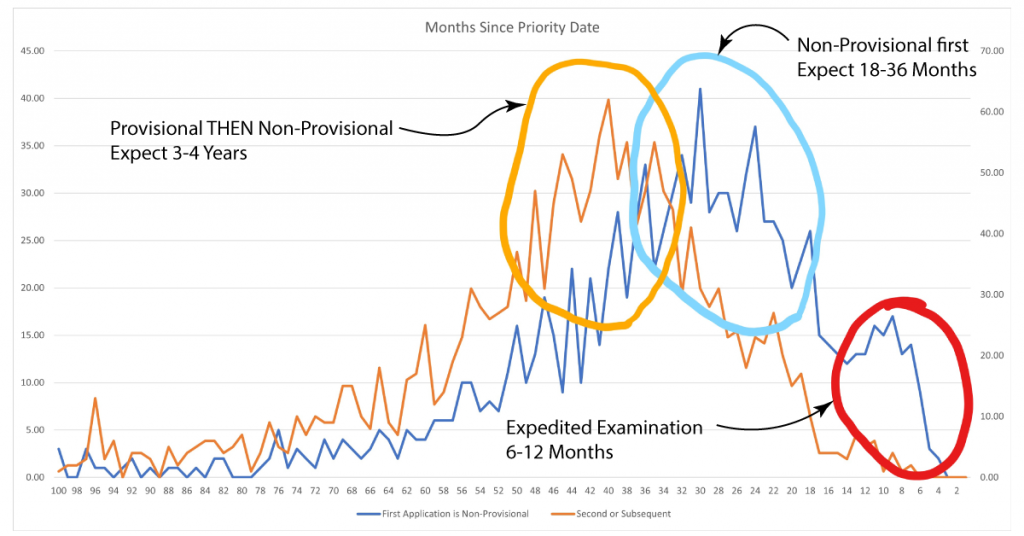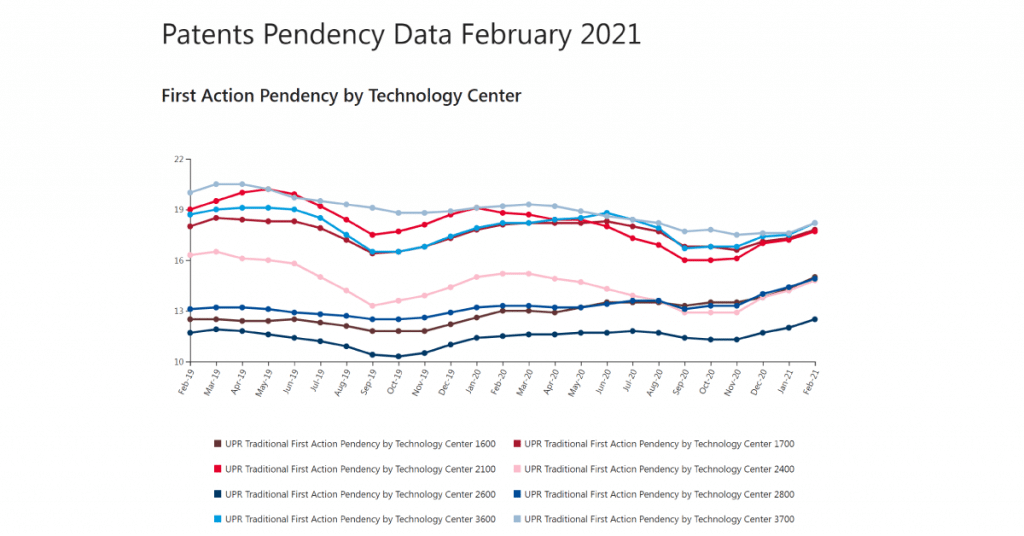How long does it take to get a patent?
It takes, on average, 2-4 years to get a patent from the United States Patent and Trademark Office. But, you can change the speed based on your filing strategy.

The chart above shows how long a patent was pending for the patents that issued to Small Entities in the first quarter of 2021. The blue line shows how long it took for patents that were filed initially as non-provisional applications and had no priority applications. The orange line shows the pendency for patents with one priority application. This (typically) means that the applicant filed a provisional patent application then filed a non-provisional a year later.
Note that this chart does not include patents for Large Entities. Their filing strategies are much different (and much more sophisticated) than Small Entities.
How long does it take to get a patent? It depends on your filing strategy.
Patent strategy for the slowest patents.
There is a patent strategy that delays getting a patent. This strategy is to file a provisional patent application, wait a year, then file a non-provisional patent application. This is exactly how a provisional patent application was intended to be used: it delays the start of examination.
Provisional patent applications were designed to give US filers an “even playing field” with foreign applicants. Under the Paris Convention, virtually all countries recognize a patent application as priority when filed within the first year. An applicant in Zimbabwe can file in their patent office, then file in the US a year later and claim priority to their Zimbabwe patent application.
What is the effect of filing overseas than filing in the US a year later? The Zimbabwe patent holder will get a patent that expires 20 years from the filing of the US application, *not* their Zimbabwe application of a year earlier.
This strategy would have the Zimbabwe patent application expire at year 21 after the earliest filing date. However, a US filer would have their patent expire at year 20.
The US lawmakers solved this problem by doing a “provisional patent application” which delays examination – and delays the patent term. The only companies that make money at the end of the patent term tend to be Big Pharma. Their product lifecycles are so long that their patents limit how much time they can sell their new drugs.
On the other hand, startups benefit the most by having patents fast.
The faster a startup gets their patent, the better. They can raise more money on an issued patent. They can enforce or license their technology. They can enter into joint venture agreements or strategic partnerships. They can use their patents as collateral for loans.
Staggeringly, the “common wisdom” is that startups should use provisional patent applications. This is self-serving advice from patent attorneys who want to lock in a client early – and selfishly take their money.
Patent strategy for “normal” (and lowest cost) patents.
The “normal” patent strategy – as used by the most sophisticated patent filers – is to file a “full” or non-provisional patent application as your first application.
In this strategy, your application gets examined as early as 12-18 months, and the patent will issue in about 24-36 months. This is the normal process for the USPTO.
This is the lowest cost patent strategy because you do not have to pay the provisional patent application fee (and probably avoid having to pay your patent attorney twice to prepare the patent application).
It should be noted that your patent will start examination sooner or later depending on the backlog of that particular group at the USPTO. The examination corps are divided into technology centers and “art units” within the technology centers. Every art unit specializes in their specific sub-section of technology, and some art units are more backlogged than others. The backlogs tend to ebb and flow over time, as the Office hires and trains more examiners, and as applicants submit more patent applications in one technology over another.
The USPTO publishes a “dashboard” that includes quite a bit of data about the Office’s backlog and how they are doing. Here is one of their graphs:

This graph shows the average time from application (or Request for Continued Examination) to the First Action. Note that RCEs often are picked up very quickly, while the First Action can take a much longer time for an application that the examiner picks up for the first time. Also, note that these applications include both Large and Small Entities, and the graph at the top of the blog post includes only Small Entities.
Note also that this graph is how long it takes to get your first Office action, not when your patent will be granted.
Use the PCT for even slower patents.
There is an even slower strategy for US patents: use the PCT (Patent Cooperation Treaty). While provisional patent applications have to be converted in 12 months, the PCT process can delay for 30 months or two and a half years before examination starts.
In general, this is not the preferred strategy for PCT applications, but it accomplishes something significant: it delays getting your patent not for one year but for two and a half years. The PCT-delay strategy is much more effective at delaying your patent costs than using a provisional patent application.
Since the biggest cost of your patent application is the back-and-forth that happens during examination, using the PCT-delay strategy might be useful to some applicants.
Please note that this strategy is *not* good for international filing. This is because you are entering national stage without (much) examination. If you are going to enter many countries with your patent, the best strategy is to get examination done early and as thoroughly as possible before the 30 month (2.5 year) deadline.
Use the PCT for even faster patents.
The PCT process gets you an early examination through an International Search Report. When these examinations are favorable, you can use the International Search Report to get expedited examination in many countries, including the US.
The process for expediting a patent based on another search report is called the Patent Prosecution Highway or PPH.
The Patent Prosecution Highway is much, much better than the USPTO’s Track One process.
Using PPH program is available from many different countries, both allowing you to get examination in one country then expedite in another.
In my experience, I am typically able to get a patent issued within 6-9 months using PPH when used properly.